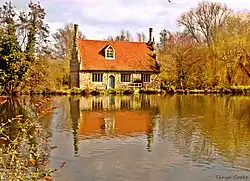Bourne Mill, Colchester
Bourne Mill is a Grade I listed former fishing lodge and then in turn a fulling mill and cornmill in the city of Colchester in Essex and is owned by the National Trust.
| Bourne Mill | |
|---|---|
 Bourne Mill and Bourne Pond | |
| Type | Watermill |
| Location | Colchester |
| Coordinates | 51°52′38″N 0°54′45″E |
| OS grid reference | TM 00565 23846 |
| Area | Essex |
| Built | 1591 |
| Rebuilt | 1640 |
| Owner | National Trust |
Listed Building – Grade I | |
| Official name | Bourne Mill |
| Designated | 24 February 1950 |
| Reference no. | 1123673 |
 Location of Bourne Mill in Essex | |
Bourne Mill, as a mill belonging to St John's Abbey
St John's Abbey was founded as a priory in 1096 and granted abbey status in 1104.[1] By 1311 Bourne Mill belonged to St John's Abbey, and may have been the Abbey's mill from the time of its foundation.[2] Its name is first recorded in c. 1240 and derives from the small stream, or bourne, south of Colchester which drove the mill.[2] It was a corn mill throughout the Middle Ages, and was possibly rebuilt in c. 1326.[2] Its pond was the Abbey's fishpond.[2]
Sir Thomas Lucas's fishing lodge
At the dissolution of the Abbey in 1539, the mill and pond passed through a number of hands before being sold to John Lucas.[2][3] John Lucas built a mansion on the site of the Abbey (subsequently destroyed during the Civil War).[3] His son, Thomas, built a fishing lodge in 1591, incorporating elements of the former Abbey and his arms above the doorway.[2][3] The gable ends are in the Dutch style, and incorporate a chimney at each end. [2]
Conversion to a mill
In 1640 the fishing lodge was fitted out as a fulling mill and run by Flemish refugees.[3] In about 1840 it then became a cornmill and remained as such until the 1930s.[3] The conversion to a cornmill resulted in the insertion of an upper floor and a sack hoist.[2]
Acquisition by the National Trust
The descendants of John Lucas continued to hold it until 1917.[2] It was acquired by the National Trust in 1936 from the last miller, Alfred Pulford, after its shaft broke.[3][4] The early history of the Trust's ownership of the mill was unsatisfactory, and by 1950 it had become derelict.[4] At that point it was Grade I listed.[5] It was converted into a house; the machinery was restored in 1966.[2][3][4]
References
- "Houses of Benedictine monks: Abbey of Colchester | British History Online". British-history.ac.uk. Retrieved 27 February 2017.
- "A P Baggs, Beryl Board, Philip Crummy, Claude Dove, Shirley Durgan, N R Goose, R B Pugh, Pamela Studd and C C Thornton, 'Mills', in A History of the County of Essex: Volume 9, the Borough of Colchester, ed. Janet Cooper and C R Elrington (London, 1994), pp. 259-264. British History Online". British-history.ac.uk. Retrieved 23 July 2023.
- "National Trust: The History of Bourne Mill". Retrieved 24 July 2023.
- "Colchester Heritage: Bourne Mill". Retrieved 24 July 2023.
- Historic England (24 February 1950). "Bourne Mill (Grade I) (1123673)". National Heritage List for England.